The proud old Powderhorn Ranch has an impressive history in our area. Many in POC have walked there, worked there, hunted there ( some even with permission…) and all of us have driven by wondering what was beyond the thick running live oak growth and high game fence beyond the gates that are so much a part of our usual drives in and out of our community. We have seen some animals we might have been unable to identify. All of us heard about a seemingly large price paid for its recent acquisition and likely wondered who pays for that. I had the opportunity to go inside those gates, see some of those animals up close and personally, and gain some answers to questions we have asked. It is a work in progress, so questions remain, but the future forecast for the Powderhorn Ranch is tremendously positive, and the intended face lift will be impressive. I for one am excited to learn about the history and the future story of this local treasure.
According to an article from Texas Monthly, February 2015, the ranch was purchased by Leroy G. Denman in 1936. He was the grandson of Capt. Richard King of King Ranch. Leroy stocked the ranch with 3000 Santa Gertrudis cattle, grazing up to 42,000 acres. He began selling some of the holding in late-1990’s, and a large chunk was purchased by billionaire Brad M. Kelley who was known to support environmental endeavors in 2008. The ranch was entirely owned by conservation minded Cumberland and Western Resources, LLC, when they agreed to sell below market value to ensure its permanent safekeeping. In 2014 the Powderhorn’s 17,350 acres were purchased by The Powderhorn Conservation Group for $37.7 million. This is the largest amount ever raised for a conservation land purchase in the state of Texas. The Powderhorn Conservation Group or PCG is made up of 4 strong organizations. The Nature Conservancy, Texas Parks and Wildlife Foundation, The Conservation Fund and National Fish and Wildlife Foundation collaborated in the PCG purchase. Almost the entire purchase price will ultimately come from the Gulf Environmental Benefit Fund, a $2.5 billion fund created with money BP and Transocean agreed to pay in plea agreements following the 2010 Deepwater Horizon rig explosion and resulting oil spill.
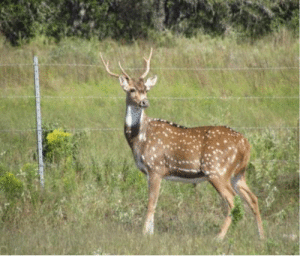
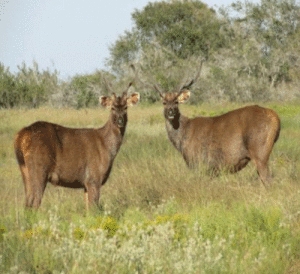
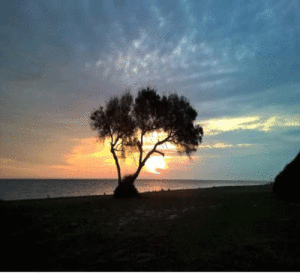
Axis Deer, Sambar Deer and beautiful sunsets are daily sights on Powderhorn Ranch.
The PCG will transfer the title fully to the Texas Parks and Wildlife Foundation by the end year 2016. The PCG has provided about 10 million in interim funding and protect and conserve the acquisition in the short-term. The Nature Conservancy will play a key role in restoring any areas that have been overgrazed or over-run with invasive species and will permanently hold a conservation easement. Ultimately, the Texas Parks and Wildlife will assume full ownership and operate an impressive State Park and Wildlife Management Area. The ranch is bounded on one side by Matagorda Bay and by Powderhorn Lake on another. This is a great opportunity for our coastal region. Larry Selzer, CEO of The Conservation Fund explained the rarity of such an undertaking. He said Powderhorn is “a unique and innovative collaboration among public and private organizations and has preserved a critical coastal landscape of epic size and scale for generations to come.”
PCG and the Texas Parks and Wildlife Department management will develop a plan of restoration and administration that protects and increases wildlife, protected species, wetlands, marshes and other habitats. They plan to seek protection and conservation of additional acres and limit development and incursion that would impact the ecosystem.
Looking past the scientific, political and financial issues, there is a jewel-like wilderness area that will become available for all to enjoy. They have dubbed it ‘keep it wild,’ and plan high quality low impact outdoor recreation.
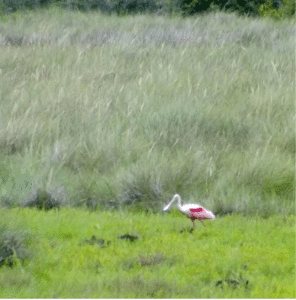
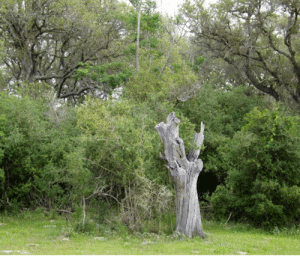
Keeping it Wild’ should be easy with scenes like this marsh area and running live oak grove…
Abundant wildlife including Sambar deer, Axis Deer, native White Tail Deer, Rio Grande Turkey, red eared slider turtles, feral hogs, vast numbers of shorebirds, songbirds, quail, snakes, reptiles, insects, raptors, waterfowl, fish, a staggering array of plant life all make their home on the Powderhorn. With brackish water, salt marshes, fresh water inlets and tidal influence, there is an estuarine habitat for vast species. The opportunities are endless. This rich resource will allow for all kinds of recreation, education, sport, study, research and leisure. Camping families, curious students, avid sportsmen and gamesmen, serious scientific researchers and wildlife artists and hobbyists will all find space and sights to enjoy in and around the Powderhorn.
For example, Smithsonian Migratory Birding Center scientists have safely netted banded and studied more than 1800 migratory birds on the ranch in the last 60 days. Their data will provide valuable information for management of the area. The Friends of the Library hosted two benefit nature tours of the Powderhorn complete with wildlife spotting, bird watching and education, expert lecture and amateur sharing of the spring sights and sounds within the boundaries of the Powderhorn. Smithsonian research scientist and educator Sean McEaleny, Texas born and educated, shared his birding and wildlife expertise with the group touring on Friday, May 8th. Tennessee Warblers, Grey Catbirds and Yellow Billed Cuckoos were just some of the migratory birds seen up close and personal, while natives such as Spoon billed Roseate, Reddish Egrets and Tricolor Herons strutted and fed on the marshes and mud flats much to the group’s delight. Axis Deer, native to India, fed calmly on the ranch byways; and Asian native Sambar Deer have fully adapted to the salt marshes and flats as they fed in families and small groups during our visit.
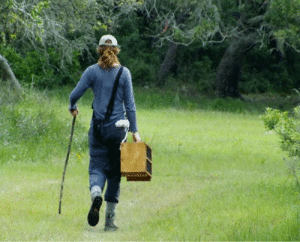
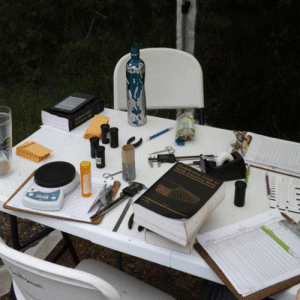
One of the Smithsonian scientists heads out with a ‘bird box’ and a stick to help raise and lower the nets. They check nets every 20 minutes or so for birds caught. They then return to the study station to gather and record the data.
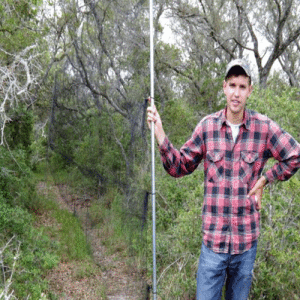
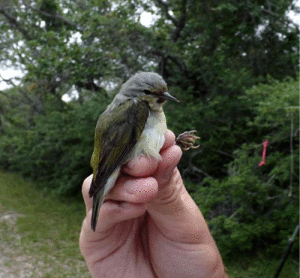
A Tennessee Warbler, about 2 yrs. old, was caught in the net at right by scientist Sean McEaleny. The birds are not hurt in this process.
Wade Harrell, US Fish and Wildlife Whooping Crane Coordinator, reported during the relaxing and delicious lunch at the historic and beautiful Powderhorn ranch house. Dr. Harrell had only good news as over 300 Whoopers were observed this year in the Aransas boundaries and the protected population continues to grow and spread. Some have even been observed outside the Aransas Refuge feeding and living in the POC and other nearby areas. Their future outlook is strong, and it is likely they will utilize areas of the conserved Powderhorn in the future.
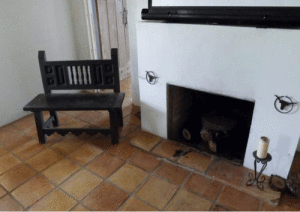
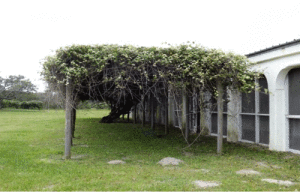
The original architecture and breathtaking views make the ranch house a gem worth preserving!
TNC Volunteers, Mid-Coast Chapter Texas Master Naturalists and POC locals Allan and Brigid Berger were our hosts for lunch. They not only provided a tasty and attractive lunch, but offered expertise about the wildlife and informed specifics about the ranch and its future plans. The buildings and structures on the ranch will need repair, updating and maintenance.
Recreational areas will need tp be designed and constructed. The new park and wildlife management area will require staffing and supervision. There is hope that schools and youth organizations will utilize and benefit from the planned park. Volunteer opportunities will be available, and that additional tourism will result. Some new jobs created with Texas Parks and Wildlife, and there will be an increase in people presence in the area. Conservation, planning and execution will be key to success! Hopefully there will be top tier advisors and experts, public input forums and meetings, careful evaluation of the ecological and economic impact, and enforceable controls and oversight. Then, this rare, beautiful and remarkable resource will be utilized and appreciated for generations to come. In the meantime, we can be proud of our state for their innovative collaboration to create the Powderhorn State Park. It will benefit our area immensely and we can be among the first and the closest to see and enjoy it.
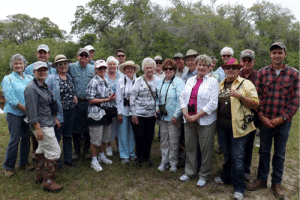
The May 8th tour group had a great time!
